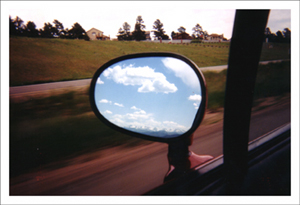About Road Way: Writerly question markers along the cyberspace highway
Cyberspace as literary space...what did that mean? That was the question that started Road Trip on its way. This entire project began with just such questions, lots and lots of them:
Was there literature in cyberspace?
What did cyberspace offer the creative writer beyond just white space for words?
What would it all mean for books?
I jotted down every question that popped into my mind about cyberspace as writing space and then I began surfing for the answers in a scholarly way. At the beginning, all I seemed to find was virtual print literature, that is, print literature with scrolling instead of page-turning. But the clicking was different: Hypertext offered a freedom to take one's own path via links. Related links thoughtfully sent me to other works of cyberliterature creativity, and they sent me to others and on and on.
The more I saw, the deeper went my questions and the more Road Way began to form in my imagination. Surely I wasn't the only one asking these questions. Surely I could create a simple website to ask and answer them. With the help of a designer friend, I took a crash course in tables and brackets and all things HTML. (See Road Map for more on that process.) I soon had the basic code skills and a nice, long research list of website URLs to help craft my questions' answers. I was ready.
But then my print publishing/academic background made me pause. As I linked to those websites, both creative and scholarly, wouldn't I somehow be using them without permission? I even asked my Web designer friend how to footnote in a website.
"Lynda," she patiently explained, "you are citing them when you link to them. They want you to link to them. The entire Internet is about finding eyes out there to link to what you're doing."
I suddenly got it. And now the lessons of this new milieu came quickly as I crafted answers to my Road Way questions. As the lessons piled up, I could see that this project could be a nice pedagogical tool, especially for instructors with limited budgets. And I began to shape it toward that end.
Lessons and Observations—"Ah-ha" and "Hmm" Moments
Road Way's lessons are somewhat self-explanatory since they are designed as questions to be answered. Some conceptual "ah-ha"and "hmm" observations beyond my new cyber-scholarly education are worthy of mention:
Design-wise, most of the mark-up language made a modicum of sense. To center something was to just type "center" between the omnipresent < > chevrons, also called angle brackets, to create a "tag." But some code seemed laughably obtuse, my favorite being the dash 'translation', which made absolutely no sense at all: A writer has to type an odd grouping of characters (—)
for a simple dash (—).
Also, something is always lost in translation in learning a new language, but in this unforgiving foreign cybercountry where perfection is mandatory, one keystroke out of place meant spending a nice chunk of time scanning for the culprit or else. A typo in a book is unfortunate; in code, it's devastating. What first evoked personal panic when my keystrokes went awry, though, soon turned into something more akin to puzzle-solving.
Style-wise, I found that the medium forced me to write as short as the research mode would allow, ever mindful of how links broadened the reading without lengthening the scroll. The medium also forced me to repeat myself in certain places, something I would never do in a print text where the reader is always assumed to be reading linearly.
In this sense, my adoption of the Q&A approach to my scholarship was also an exercise in the non-linearity of hypertext literature, heightening not only the much-heralded effect but also the inherent problems in non-linearity and the pursuit of their acceptable solutions. Sometimes I thought my solutions acceptable, sometimes I didn't, but every problem taught me something about the medium itself.
Research-wise, I marveled at the literary diversity, noticing quickly that cyberspace did lend itself to certain forms. Longer works of literature attempted in cyberspace seem somewhat "arrested," their scrolling a handicap. But the same isn't true for shorter forms. Flash poetry is a good example of an exception with its subgenre-creating, digitally animating software. But part of the fun included the non-conforming surprises. Where else to so suddenly discover American Sign Language Poetry, for example?
Roadsite Attractions—Road Trip's Site-seeing Fun
As Road Way began to form, I enjoyed the creative projects I discovered so much that I decided to link to a select group of them for another dimension of my Road Trip, on both Road Way and Road Reverie.
I called the diamond-shaped links: "Roadsite Attractions."
My choices for the site-seeing of "Roadsite Attractions" were meant to convey my newfound appreciation for this diversity, past and present, including as many different interpretations of cyberspace as literary space as possible. Not to mention my impulse to share the sheer joy of the cleverness and fun.
And I offer it all in the same way I offer my answered questions—as the fascinating result of wandering around in a universe of cyber-literary investigation.
| Road Way |
| Writerly "question markers" along the cyberspace highway
|
 |
Return Home